Brisbane SP22 CO5123: Accounting for Leases and AASB Impact Analysis
VerifiedAdded on 2023/06/07
|9
|2724
|263
Essay
AI Summary
This essay analyzes the accounting treatment of leases, focusing on the impact of AASB 16 (IFRS 16) on financial reporting. It defines financial and operating leases, comparing their characteristics and implications. The paper explores the short-term and long-term effects of the new lease accounting standards, using JB Hi-Fi as a case study to illustrate the practical consequences of these changes. It examines the company's current lease structure, recognition and measurement of leases, and the expected impacts of the new standards on its financial ratios. Furthermore, the essay includes an analysis of the article, highlighting the historical context of lease accounting and the rationale behind the new standards, particularly in addressing off-balance sheet financing and improving comparability of financial information across different sectors, like aviation. The essay concludes with a discussion of the benefits and challenges associated with the adoption of the new lease accounting standards.
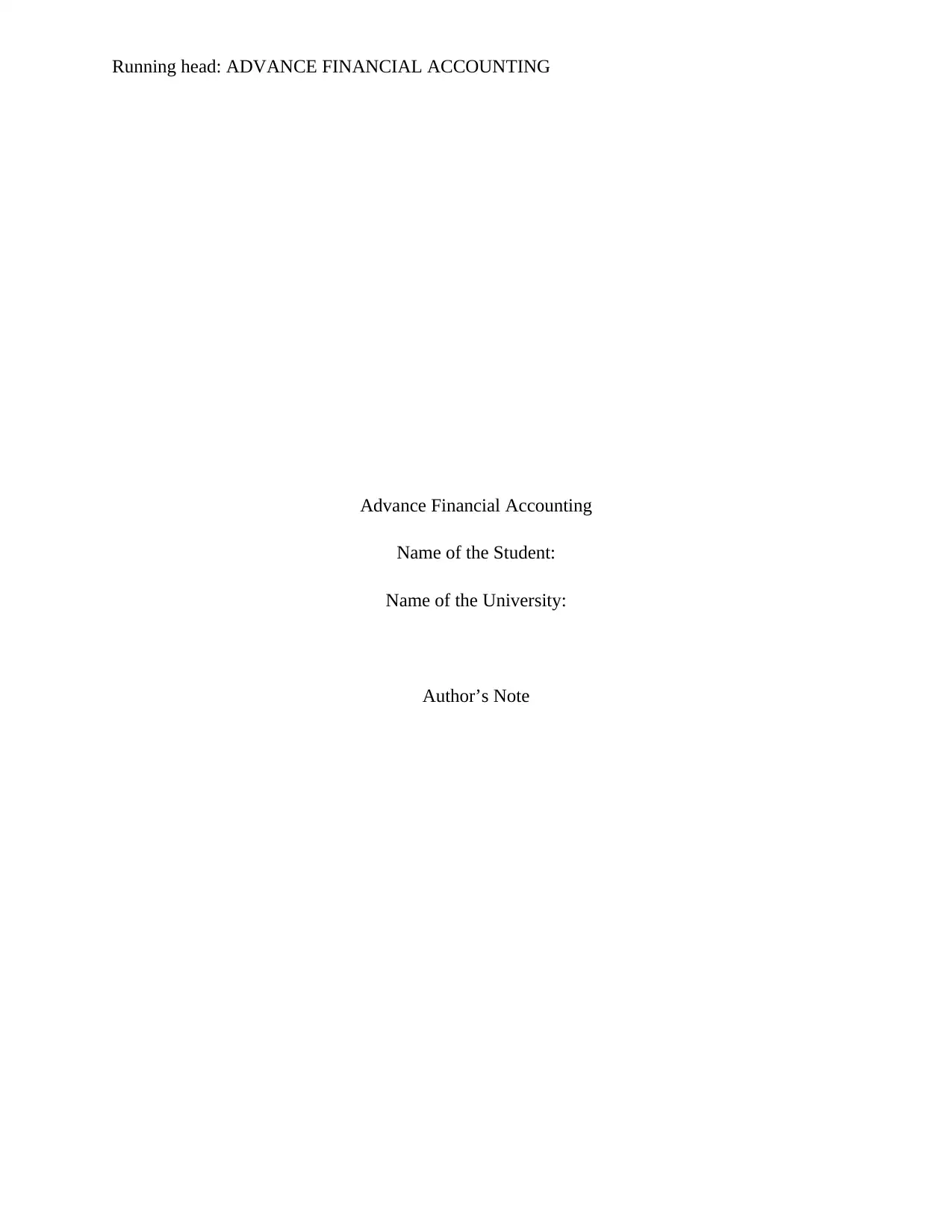
Running head: ADVANCE FINANCIAL ACCOUNTING
Advance Financial Accounting
Name of the Student:
Name of the University:
Author’s Note
Advance Financial Accounting
Name of the Student:
Name of the University:
Author’s Note
Paraphrase This Document
Need a fresh take? Get an instant paraphrase of this document with our AI Paraphraser
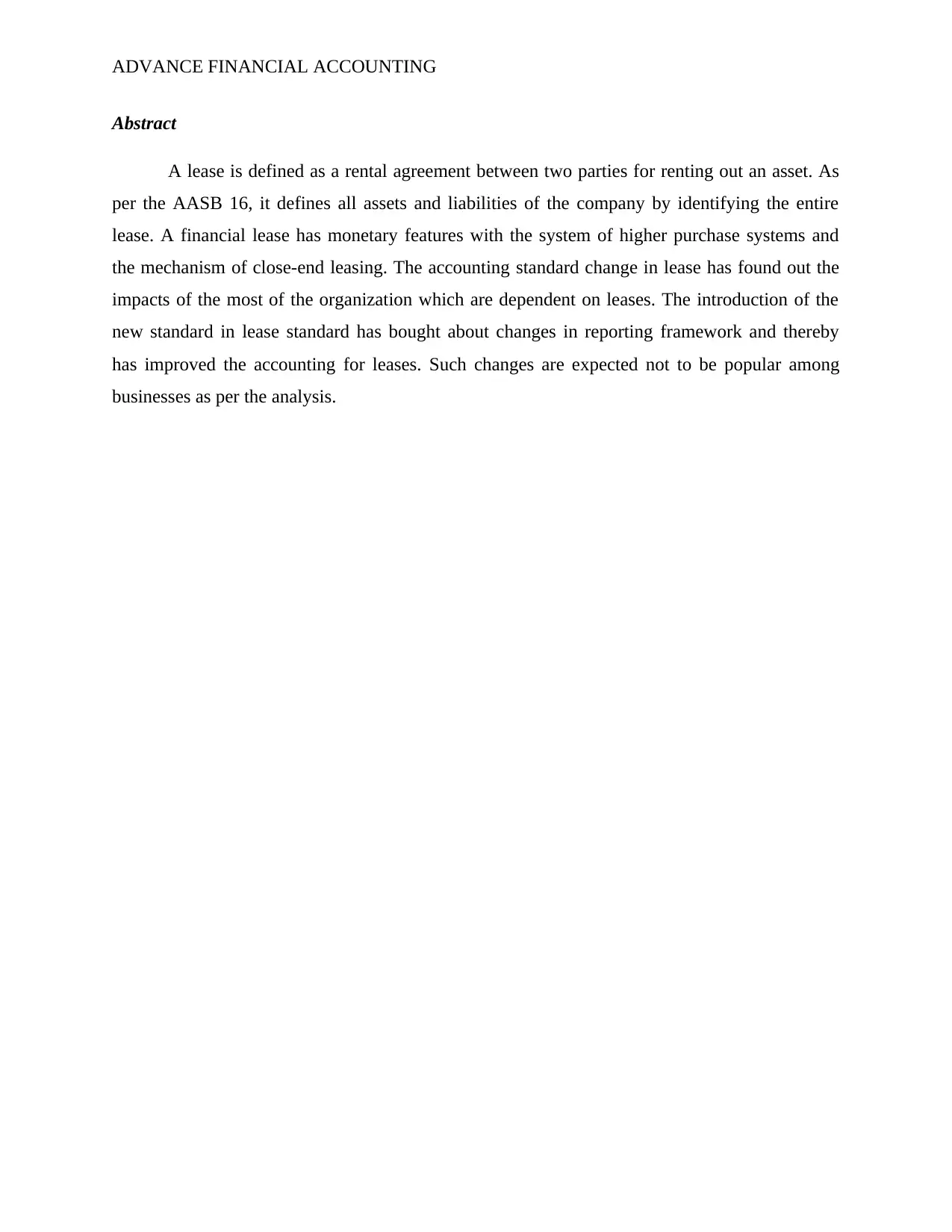
ADVANCE FINANCIAL ACCOUNTING
Abstract
A lease is defined as a rental agreement between two parties for renting out an asset. As
per the AASB 16, it defines all assets and liabilities of the company by identifying the entire
lease. A financial lease has monetary features with the system of higher purchase systems and
the mechanism of close-end leasing. The accounting standard change in lease has found out the
impacts of the most of the organization which are dependent on leases. The introduction of the
new standard in lease standard has bought about changes in reporting framework and thereby
has improved the accounting for leases. Such changes are expected not to be popular among
businesses as per the analysis.
Abstract
A lease is defined as a rental agreement between two parties for renting out an asset. As
per the AASB 16, it defines all assets and liabilities of the company by identifying the entire
lease. A financial lease has monetary features with the system of higher purchase systems and
the mechanism of close-end leasing. The accounting standard change in lease has found out the
impacts of the most of the organization which are dependent on leases. The introduction of the
new standard in lease standard has bought about changes in reporting framework and thereby
has improved the accounting for leases. Such changes are expected not to be popular among
businesses as per the analysis.
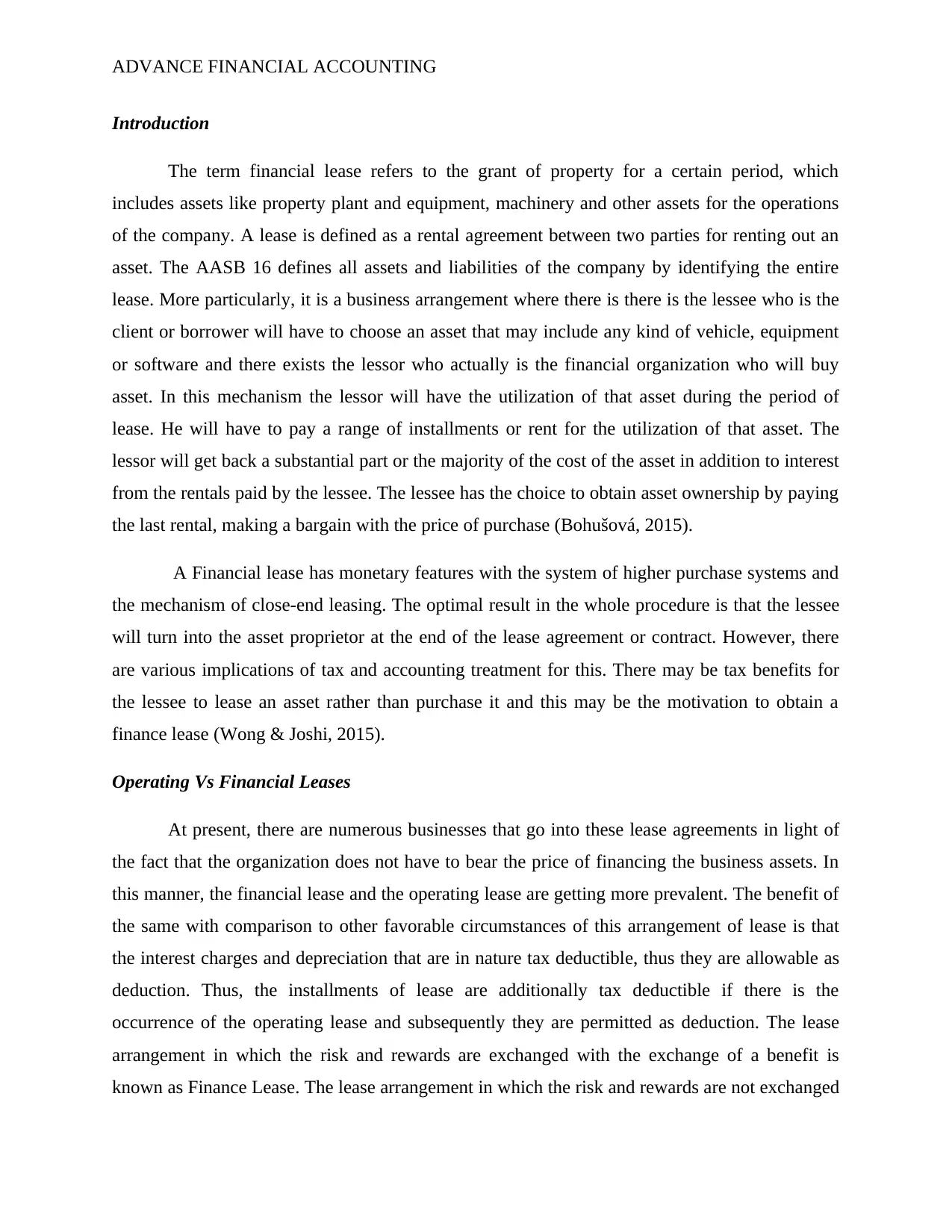
ADVANCE FINANCIAL ACCOUNTING
Introduction
The term financial lease refers to the grant of property for a certain period, which
includes assets like property plant and equipment, machinery and other assets for the operations
of the company. A lease is defined as a rental agreement between two parties for renting out an
asset. The AASB 16 defines all assets and liabilities of the company by identifying the entire
lease. More particularly, it is a business arrangement where there is there is the lessee who is the
client or borrower will have to choose an asset that may include any kind of vehicle, equipment
or software and there exists the lessor who actually is the financial organization who will buy
asset. In this mechanism the lessor will have the utilization of that asset during the period of
lease. He will have to pay a range of installments or rent for the utilization of that asset. The
lessor will get back a substantial part or the majority of the cost of the asset in addition to interest
from the rentals paid by the lessee. The lessee has the choice to obtain asset ownership by paying
the last rental, making a bargain with the price of purchase (Bohušová, 2015).
A Financial lease has monetary features with the system of higher purchase systems and
the mechanism of close-end leasing. The optimal result in the whole procedure is that the lessee
will turn into the asset proprietor at the end of the lease agreement or contract. However, there
are various implications of tax and accounting treatment for this. There may be tax benefits for
the lessee to lease an asset rather than purchase it and this may be the motivation to obtain a
finance lease (Wong & Joshi, 2015).
Operating Vs Financial Leases
At present, there are numerous businesses that go into these lease agreements in light of
the fact that the organization does not have to bear the price of financing the business assets. In
this manner, the financial lease and the operating lease are getting more prevalent. The benefit of
the same with comparison to other favorable circumstances of this arrangement of lease is that
the interest charges and depreciation that are in nature tax deductible, thus they are allowable as
deduction. Thus, the installments of lease are additionally tax deductible if there is the
occurrence of the operating lease and subsequently they are permitted as deduction. The lease
arrangement in which the risk and rewards are exchanged with the exchange of a benefit is
known as Finance Lease. The lease arrangement in which the risk and rewards are not exchanged
Introduction
The term financial lease refers to the grant of property for a certain period, which
includes assets like property plant and equipment, machinery and other assets for the operations
of the company. A lease is defined as a rental agreement between two parties for renting out an
asset. The AASB 16 defines all assets and liabilities of the company by identifying the entire
lease. More particularly, it is a business arrangement where there is there is the lessee who is the
client or borrower will have to choose an asset that may include any kind of vehicle, equipment
or software and there exists the lessor who actually is the financial organization who will buy
asset. In this mechanism the lessor will have the utilization of that asset during the period of
lease. He will have to pay a range of installments or rent for the utilization of that asset. The
lessor will get back a substantial part or the majority of the cost of the asset in addition to interest
from the rentals paid by the lessee. The lessee has the choice to obtain asset ownership by paying
the last rental, making a bargain with the price of purchase (Bohušová, 2015).
A Financial lease has monetary features with the system of higher purchase systems and
the mechanism of close-end leasing. The optimal result in the whole procedure is that the lessee
will turn into the asset proprietor at the end of the lease agreement or contract. However, there
are various implications of tax and accounting treatment for this. There may be tax benefits for
the lessee to lease an asset rather than purchase it and this may be the motivation to obtain a
finance lease (Wong & Joshi, 2015).
Operating Vs Financial Leases
At present, there are numerous businesses that go into these lease agreements in light of
the fact that the organization does not have to bear the price of financing the business assets. In
this manner, the financial lease and the operating lease are getting more prevalent. The benefit of
the same with comparison to other favorable circumstances of this arrangement of lease is that
the interest charges and depreciation that are in nature tax deductible, thus they are allowable as
deduction. Thus, the installments of lease are additionally tax deductible if there is the
occurrence of the operating lease and subsequently they are permitted as deduction. The lease
arrangement in which the risk and rewards are exchanged with the exchange of a benefit is
known as Finance Lease. The lease arrangement in which the risk and rewards are not exchanged
⊘ This is a preview!⊘
Do you want full access?
Subscribe today to unlock all pages.

Trusted by 1+ million students worldwide
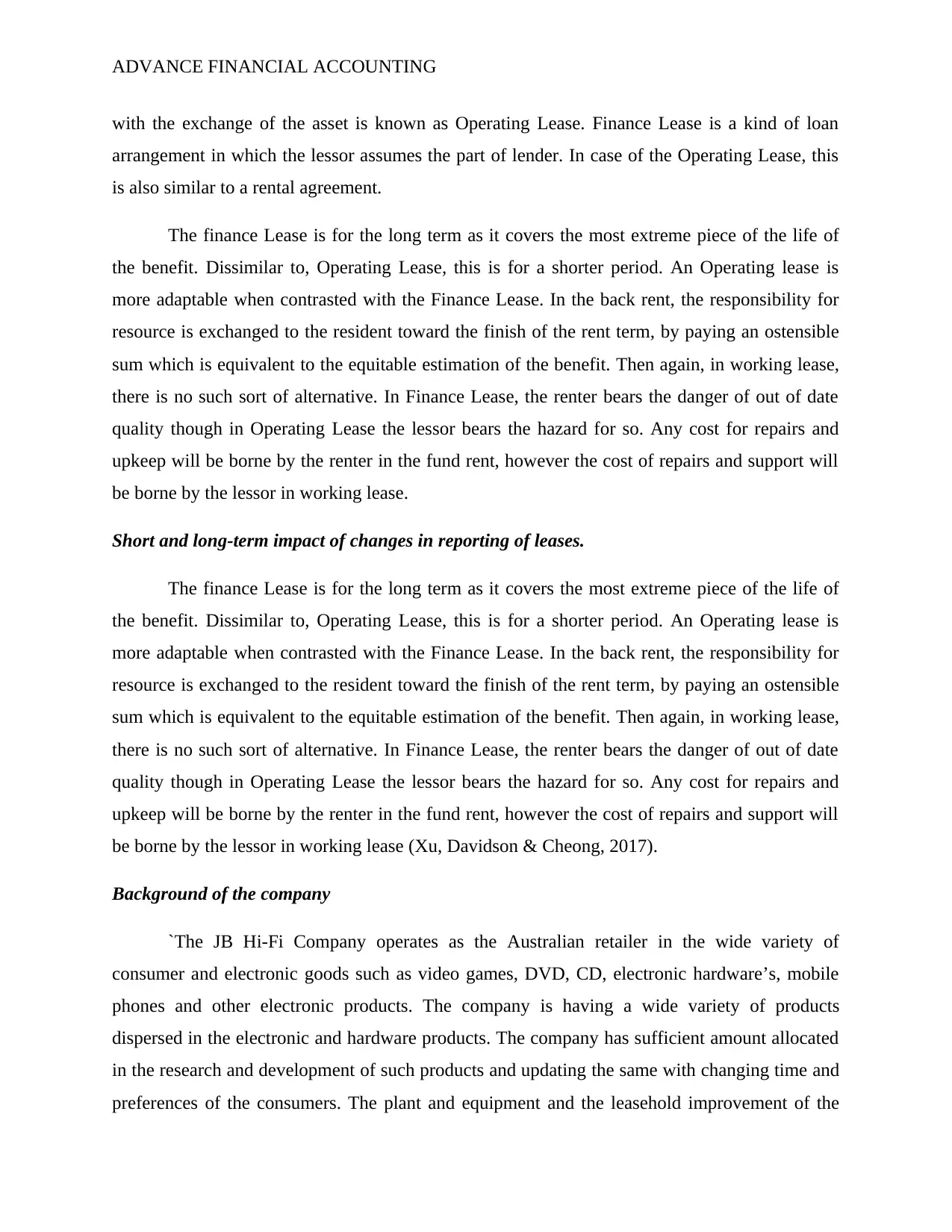
ADVANCE FINANCIAL ACCOUNTING
with the exchange of the asset is known as Operating Lease. Finance Lease is a kind of loan
arrangement in which the lessor assumes the part of lender. In case of the Operating Lease, this
is also similar to a rental agreement.
The finance Lease is for the long term as it covers the most extreme piece of the life of
the benefit. Dissimilar to, Operating Lease, this is for a shorter period. An Operating lease is
more adaptable when contrasted with the Finance Lease. In the back rent, the responsibility for
resource is exchanged to the resident toward the finish of the rent term, by paying an ostensible
sum which is equivalent to the equitable estimation of the benefit. Then again, in working lease,
there is no such sort of alternative. In Finance Lease, the renter bears the danger of out of date
quality though in Operating Lease the lessor bears the hazard for so. Any cost for repairs and
upkeep will be borne by the renter in the fund rent, however the cost of repairs and support will
be borne by the lessor in working lease.
Short and long-term impact of changes in reporting of leases.
The finance Lease is for the long term as it covers the most extreme piece of the life of
the benefit. Dissimilar to, Operating Lease, this is for a shorter period. An Operating lease is
more adaptable when contrasted with the Finance Lease. In the back rent, the responsibility for
resource is exchanged to the resident toward the finish of the rent term, by paying an ostensible
sum which is equivalent to the equitable estimation of the benefit. Then again, in working lease,
there is no such sort of alternative. In Finance Lease, the renter bears the danger of out of date
quality though in Operating Lease the lessor bears the hazard for so. Any cost for repairs and
upkeep will be borne by the renter in the fund rent, however the cost of repairs and support will
be borne by the lessor in working lease (Xu, Davidson & Cheong, 2017).
Background of the company
`The JB Hi-Fi Company operates as the Australian retailer in the wide variety of
consumer and electronic goods such as video games, DVD, CD, electronic hardware’s, mobile
phones and other electronic products. The company is having a wide variety of products
dispersed in the electronic and hardware products. The company has sufficient amount allocated
in the research and development of such products and updating the same with changing time and
preferences of the consumers. The plant and equipment and the leasehold improvement of the
with the exchange of the asset is known as Operating Lease. Finance Lease is a kind of loan
arrangement in which the lessor assumes the part of lender. In case of the Operating Lease, this
is also similar to a rental agreement.
The finance Lease is for the long term as it covers the most extreme piece of the life of
the benefit. Dissimilar to, Operating Lease, this is for a shorter period. An Operating lease is
more adaptable when contrasted with the Finance Lease. In the back rent, the responsibility for
resource is exchanged to the resident toward the finish of the rent term, by paying an ostensible
sum which is equivalent to the equitable estimation of the benefit. Then again, in working lease,
there is no such sort of alternative. In Finance Lease, the renter bears the danger of out of date
quality though in Operating Lease the lessor bears the hazard for so. Any cost for repairs and
upkeep will be borne by the renter in the fund rent, however the cost of repairs and support will
be borne by the lessor in working lease.
Short and long-term impact of changes in reporting of leases.
The finance Lease is for the long term as it covers the most extreme piece of the life of
the benefit. Dissimilar to, Operating Lease, this is for a shorter period. An Operating lease is
more adaptable when contrasted with the Finance Lease. In the back rent, the responsibility for
resource is exchanged to the resident toward the finish of the rent term, by paying an ostensible
sum which is equivalent to the equitable estimation of the benefit. Then again, in working lease,
there is no such sort of alternative. In Finance Lease, the renter bears the danger of out of date
quality though in Operating Lease the lessor bears the hazard for so. Any cost for repairs and
upkeep will be borne by the renter in the fund rent, however the cost of repairs and support will
be borne by the lessor in working lease (Xu, Davidson & Cheong, 2017).
Background of the company
`The JB Hi-Fi Company operates as the Australian retailer in the wide variety of
consumer and electronic goods such as video games, DVD, CD, electronic hardware’s, mobile
phones and other electronic products. The company is having a wide variety of products
dispersed in the electronic and hardware products. The company has sufficient amount allocated
in the research and development of such products and updating the same with changing time and
preferences of the consumers. The plant and equipment and the leasehold improvement of the
Paraphrase This Document
Need a fresh take? Get an instant paraphrase of this document with our AI Paraphraser
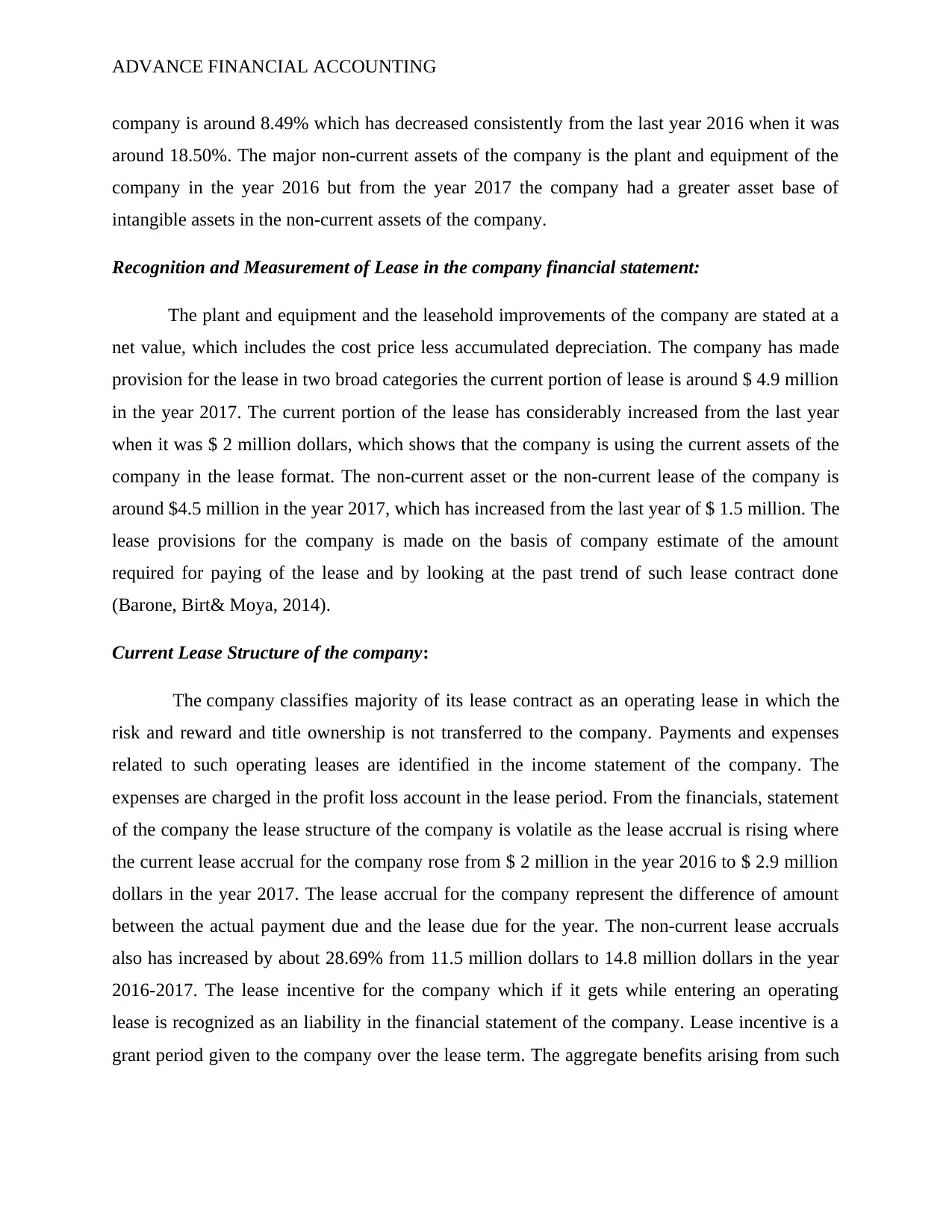
ADVANCE FINANCIAL ACCOUNTING
company is around 8.49% which has decreased consistently from the last year 2016 when it was
around 18.50%. The major non-current assets of the company is the plant and equipment of the
company in the year 2016 but from the year 2017 the company had a greater asset base of
intangible assets in the non-current assets of the company.
Recognition and Measurement of Lease in the company financial statement:
The plant and equipment and the leasehold improvements of the company are stated at a
net value, which includes the cost price less accumulated depreciation. The company has made
provision for the lease in two broad categories the current portion of lease is around $ 4.9 million
in the year 2017. The current portion of the lease has considerably increased from the last year
when it was $ 2 million dollars, which shows that the company is using the current assets of the
company in the lease format. The non-current asset or the non-current lease of the company is
around $4.5 million in the year 2017, which has increased from the last year of $ 1.5 million. The
lease provisions for the company is made on the basis of company estimate of the amount
required for paying of the lease and by looking at the past trend of such lease contract done
(Barone, Birt& Moya, 2014).
Current Lease Structure of the company:
The company classifies majority of its lease contract as an operating lease in which the
risk and reward and title ownership is not transferred to the company. Payments and expenses
related to such operating leases are identified in the income statement of the company. The
expenses are charged in the profit loss account in the lease period. From the financials, statement
of the company the lease structure of the company is volatile as the lease accrual is rising where
the current lease accrual for the company rose from $ 2 million in the year 2016 to $ 2.9 million
dollars in the year 2017. The lease accrual for the company represent the difference of amount
between the actual payment due and the lease due for the year. The non-current lease accruals
also has increased by about 28.69% from 11.5 million dollars to 14.8 million dollars in the year
2016-2017. The lease incentive for the company which if it gets while entering an operating
lease is recognized as an liability in the financial statement of the company. Lease incentive is a
grant period given to the company over the lease term. The aggregate benefits arising from such
company is around 8.49% which has decreased consistently from the last year 2016 when it was
around 18.50%. The major non-current assets of the company is the plant and equipment of the
company in the year 2016 but from the year 2017 the company had a greater asset base of
intangible assets in the non-current assets of the company.
Recognition and Measurement of Lease in the company financial statement:
The plant and equipment and the leasehold improvements of the company are stated at a
net value, which includes the cost price less accumulated depreciation. The company has made
provision for the lease in two broad categories the current portion of lease is around $ 4.9 million
in the year 2017. The current portion of the lease has considerably increased from the last year
when it was $ 2 million dollars, which shows that the company is using the current assets of the
company in the lease format. The non-current asset or the non-current lease of the company is
around $4.5 million in the year 2017, which has increased from the last year of $ 1.5 million. The
lease provisions for the company is made on the basis of company estimate of the amount
required for paying of the lease and by looking at the past trend of such lease contract done
(Barone, Birt& Moya, 2014).
Current Lease Structure of the company:
The company classifies majority of its lease contract as an operating lease in which the
risk and reward and title ownership is not transferred to the company. Payments and expenses
related to such operating leases are identified in the income statement of the company. The
expenses are charged in the profit loss account in the lease period. From the financials, statement
of the company the lease structure of the company is volatile as the lease accrual is rising where
the current lease accrual for the company rose from $ 2 million in the year 2016 to $ 2.9 million
dollars in the year 2017. The lease accrual for the company represent the difference of amount
between the actual payment due and the lease due for the year. The non-current lease accruals
also has increased by about 28.69% from 11.5 million dollars to 14.8 million dollars in the year
2016-2017. The lease incentive for the company which if it gets while entering an operating
lease is recognized as an liability in the financial statement of the company. Lease incentive is a
grant period given to the company over the lease term. The aggregate benefits arising from such
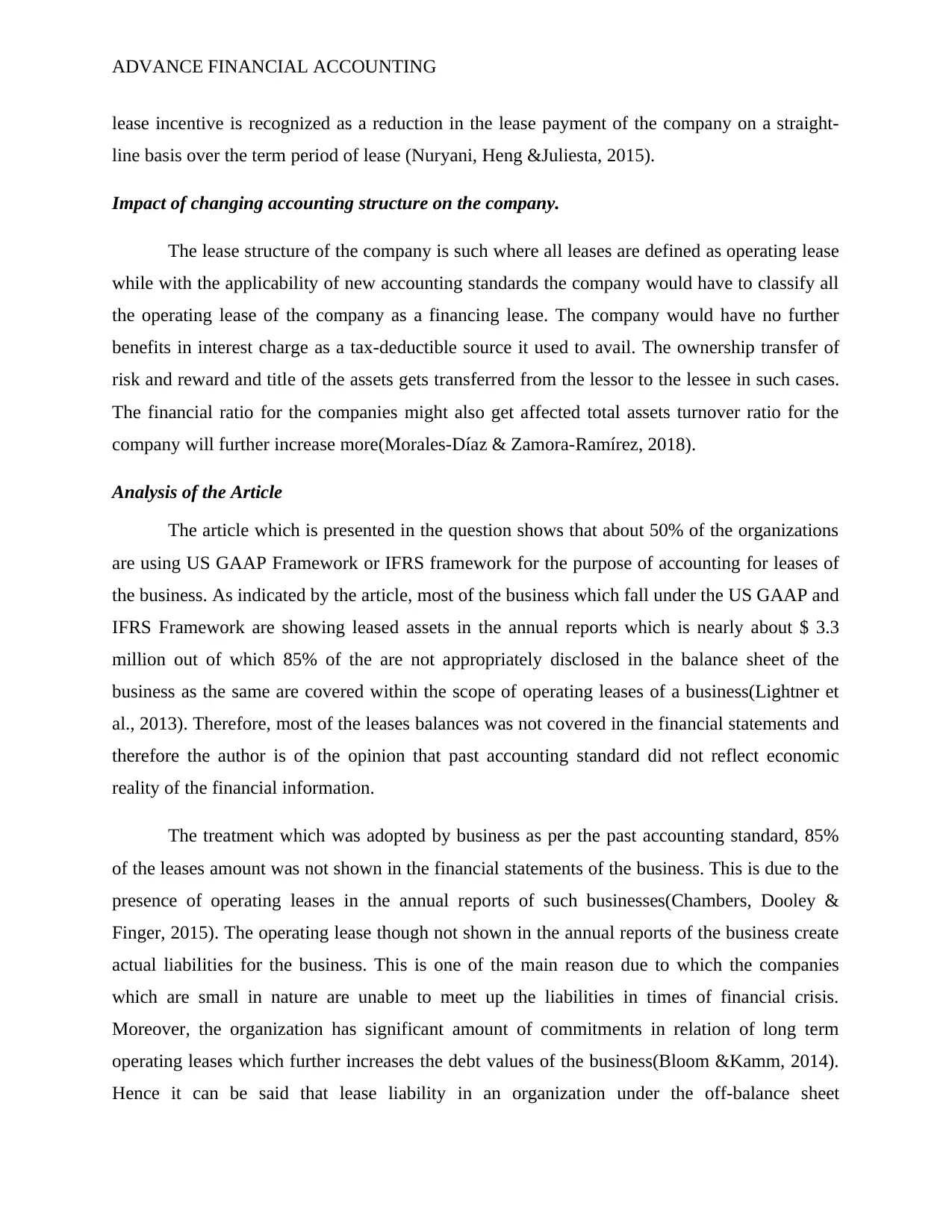
ADVANCE FINANCIAL ACCOUNTING
lease incentive is recognized as a reduction in the lease payment of the company on a straight-
line basis over the term period of lease (Nuryani, Heng &Juliesta, 2015).
Impact of changing accounting structure on the company.
The lease structure of the company is such where all leases are defined as operating lease
while with the applicability of new accounting standards the company would have to classify all
the operating lease of the company as a financing lease. The company would have no further
benefits in interest charge as a tax-deductible source it used to avail. The ownership transfer of
risk and reward and title of the assets gets transferred from the lessor to the lessee in such cases.
The financial ratio for the companies might also get affected total assets turnover ratio for the
company will further increase more(Morales-Díaz & Zamora-Ramírez, 2018).
Analysis of the Article
The article which is presented in the question shows that about 50% of the organizations
are using US GAAP Framework or IFRS framework for the purpose of accounting for leases of
the business. As indicated by the article, most of the business which fall under the US GAAP and
IFRS Framework are showing leased assets in the annual reports which is nearly about $ 3.3
million out of which 85% of the are not appropriately disclosed in the balance sheet of the
business as the same are covered within the scope of operating leases of a business(Lightner et
al., 2013). Therefore, most of the leases balances was not covered in the financial statements and
therefore the author is of the opinion that past accounting standard did not reflect economic
reality of the financial information.
The treatment which was adopted by business as per the past accounting standard, 85%
of the leases amount was not shown in the financial statements of the business. This is due to the
presence of operating leases in the annual reports of such businesses(Chambers, Dooley &
Finger, 2015). The operating lease though not shown in the annual reports of the business create
actual liabilities for the business. This is one of the main reason due to which the companies
which are small in nature are unable to meet up the liabilities in times of financial crisis.
Moreover, the organization has significant amount of commitments in relation of long term
operating leases which further increases the debt values of the business(Bloom &Kamm, 2014).
Hence it can be said that lease liability in an organization under the off-balance sheet
lease incentive is recognized as a reduction in the lease payment of the company on a straight-
line basis over the term period of lease (Nuryani, Heng &Juliesta, 2015).
Impact of changing accounting structure on the company.
The lease structure of the company is such where all leases are defined as operating lease
while with the applicability of new accounting standards the company would have to classify all
the operating lease of the company as a financing lease. The company would have no further
benefits in interest charge as a tax-deductible source it used to avail. The ownership transfer of
risk and reward and title of the assets gets transferred from the lessor to the lessee in such cases.
The financial ratio for the companies might also get affected total assets turnover ratio for the
company will further increase more(Morales-Díaz & Zamora-Ramírez, 2018).
Analysis of the Article
The article which is presented in the question shows that about 50% of the organizations
are using US GAAP Framework or IFRS framework for the purpose of accounting for leases of
the business. As indicated by the article, most of the business which fall under the US GAAP and
IFRS Framework are showing leased assets in the annual reports which is nearly about $ 3.3
million out of which 85% of the are not appropriately disclosed in the balance sheet of the
business as the same are covered within the scope of operating leases of a business(Lightner et
al., 2013). Therefore, most of the leases balances was not covered in the financial statements and
therefore the author is of the opinion that past accounting standard did not reflect economic
reality of the financial information.
The treatment which was adopted by business as per the past accounting standard, 85%
of the leases amount was not shown in the financial statements of the business. This is due to the
presence of operating leases in the annual reports of such businesses(Chambers, Dooley &
Finger, 2015). The operating lease though not shown in the annual reports of the business create
actual liabilities for the business. This is one of the main reason due to which the companies
which are small in nature are unable to meet up the liabilities in times of financial crisis.
Moreover, the organization has significant amount of commitments in relation of long term
operating leases which further increases the debt values of the business(Bloom &Kamm, 2014).
Hence it can be said that lease liability in an organization under the off-balance sheet
⊘ This is a preview!⊘
Do you want full access?
Subscribe today to unlock all pages.

Trusted by 1+ million students worldwide
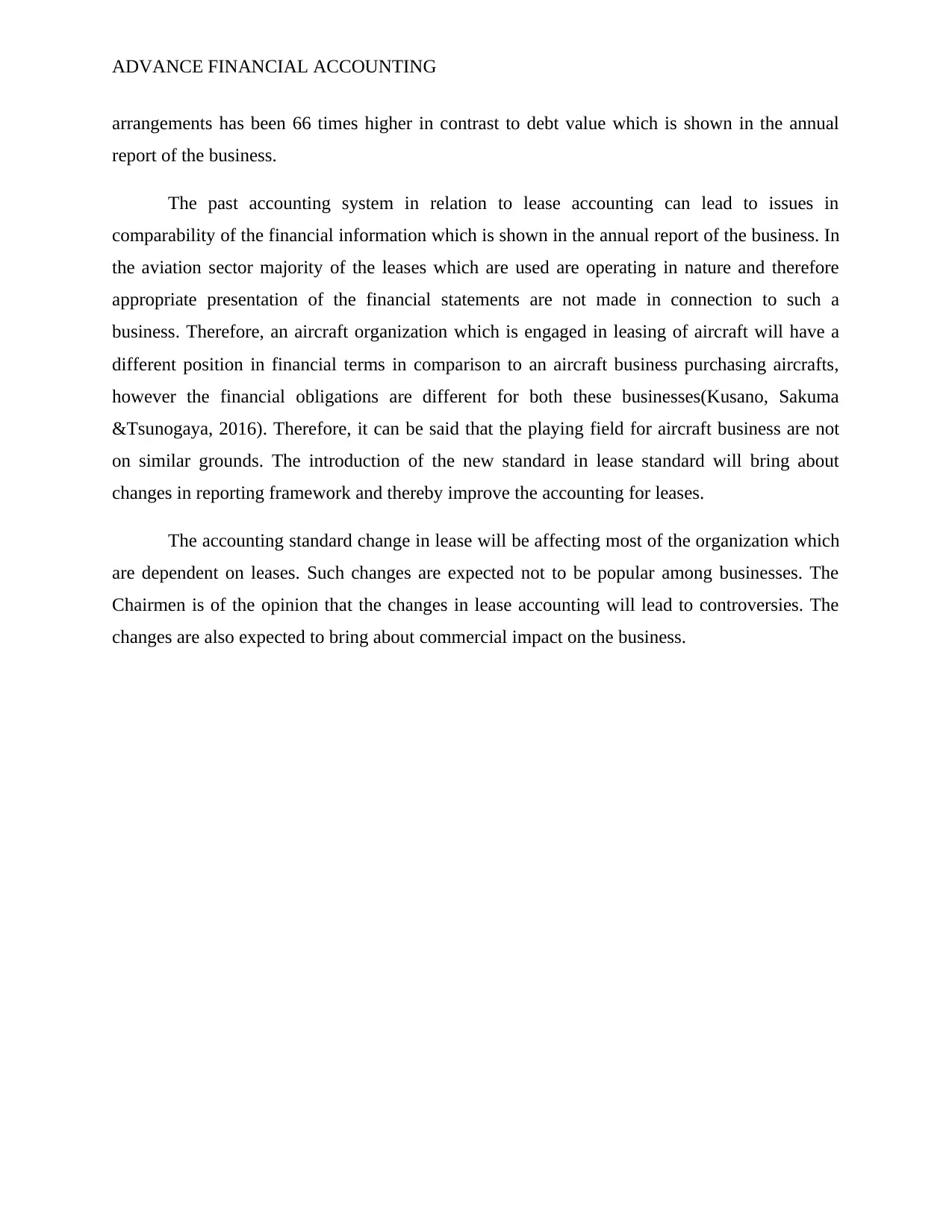
ADVANCE FINANCIAL ACCOUNTING
arrangements has been 66 times higher in contrast to debt value which is shown in the annual
report of the business.
The past accounting system in relation to lease accounting can lead to issues in
comparability of the financial information which is shown in the annual report of the business. In
the aviation sector majority of the leases which are used are operating in nature and therefore
appropriate presentation of the financial statements are not made in connection to such a
business. Therefore, an aircraft organization which is engaged in leasing of aircraft will have a
different position in financial terms in comparison to an aircraft business purchasing aircrafts,
however the financial obligations are different for both these businesses(Kusano, Sakuma
&Tsunogaya, 2016). Therefore, it can be said that the playing field for aircraft business are not
on similar grounds. The introduction of the new standard in lease standard will bring about
changes in reporting framework and thereby improve the accounting for leases.
The accounting standard change in lease will be affecting most of the organization which
are dependent on leases. Such changes are expected not to be popular among businesses. The
Chairmen is of the opinion that the changes in lease accounting will lead to controversies. The
changes are also expected to bring about commercial impact on the business.
arrangements has been 66 times higher in contrast to debt value which is shown in the annual
report of the business.
The past accounting system in relation to lease accounting can lead to issues in
comparability of the financial information which is shown in the annual report of the business. In
the aviation sector majority of the leases which are used are operating in nature and therefore
appropriate presentation of the financial statements are not made in connection to such a
business. Therefore, an aircraft organization which is engaged in leasing of aircraft will have a
different position in financial terms in comparison to an aircraft business purchasing aircrafts,
however the financial obligations are different for both these businesses(Kusano, Sakuma
&Tsunogaya, 2016). Therefore, it can be said that the playing field for aircraft business are not
on similar grounds. The introduction of the new standard in lease standard will bring about
changes in reporting framework and thereby improve the accounting for leases.
The accounting standard change in lease will be affecting most of the organization which
are dependent on leases. Such changes are expected not to be popular among businesses. The
Chairmen is of the opinion that the changes in lease accounting will lead to controversies. The
changes are also expected to bring about commercial impact on the business.
Paraphrase This Document
Need a fresh take? Get an instant paraphrase of this document with our AI Paraphraser
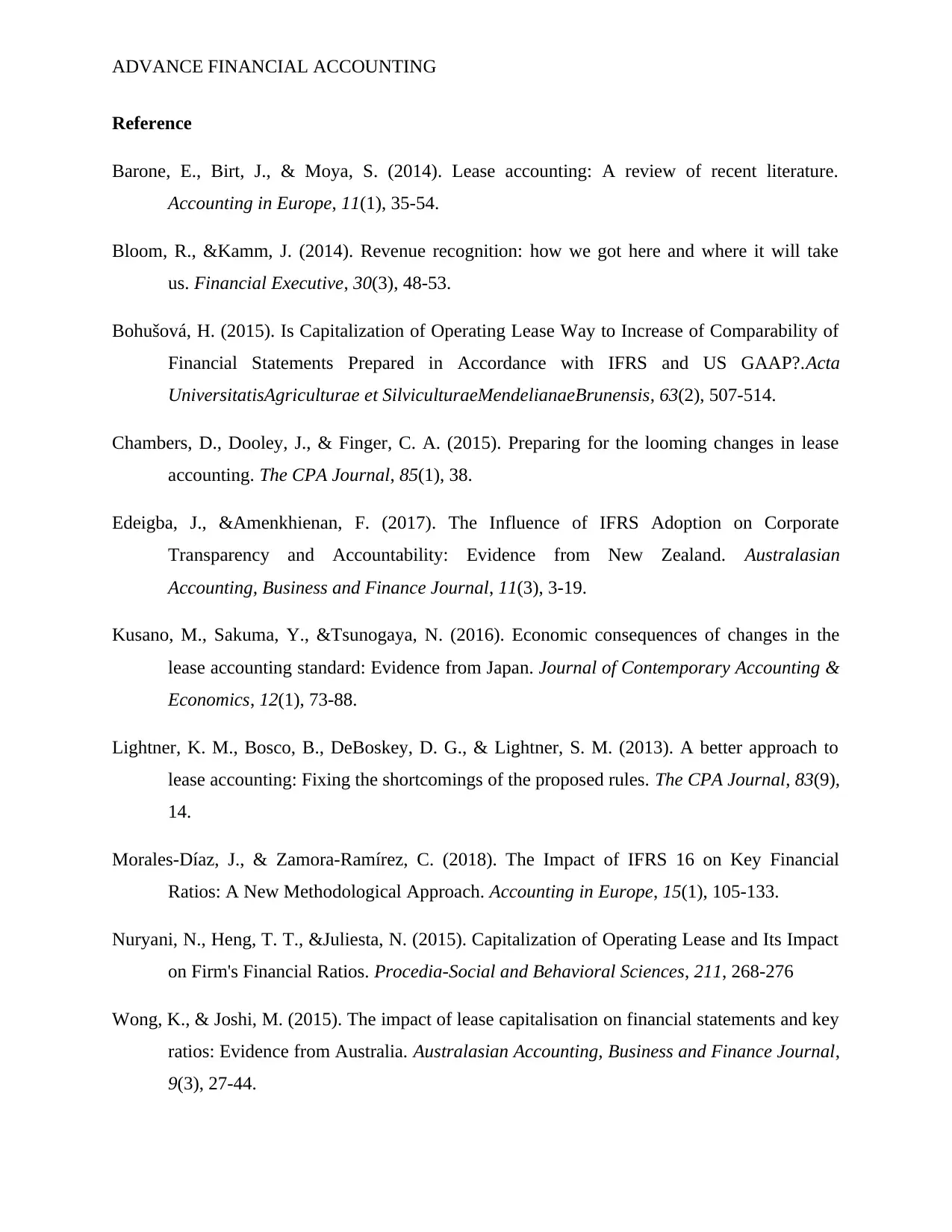
ADVANCE FINANCIAL ACCOUNTING
Reference
Barone, E., Birt, J., & Moya, S. (2014). Lease accounting: A review of recent literature.
Accounting in Europe, 11(1), 35-54.
Bloom, R., &Kamm, J. (2014). Revenue recognition: how we got here and where it will take
us. Financial Executive, 30(3), 48-53.
Bohušová, H. (2015). Is Capitalization of Operating Lease Way to Increase of Comparability of
Financial Statements Prepared in Accordance with IFRS and US GAAP?.Acta
UniversitatisAgriculturae et SilviculturaeMendelianaeBrunensis, 63(2), 507-514.
Chambers, D., Dooley, J., & Finger, C. A. (2015). Preparing for the looming changes in lease
accounting. The CPA Journal, 85(1), 38.
Edeigba, J., &Amenkhienan, F. (2017). The Influence of IFRS Adoption on Corporate
Transparency and Accountability: Evidence from New Zealand. Australasian
Accounting, Business and Finance Journal, 11(3), 3-19.
Kusano, M., Sakuma, Y., &Tsunogaya, N. (2016). Economic consequences of changes in the
lease accounting standard: Evidence from Japan. Journal of Contemporary Accounting &
Economics, 12(1), 73-88.
Lightner, K. M., Bosco, B., DeBoskey, D. G., & Lightner, S. M. (2013). A better approach to
lease accounting: Fixing the shortcomings of the proposed rules. The CPA Journal, 83(9),
14.
Morales-Díaz, J., & Zamora-Ramírez, C. (2018). The Impact of IFRS 16 on Key Financial
Ratios: A New Methodological Approach. Accounting in Europe, 15(1), 105-133.
Nuryani, N., Heng, T. T., &Juliesta, N. (2015). Capitalization of Operating Lease and Its Impact
on Firm's Financial Ratios. Procedia-Social and Behavioral Sciences, 211, 268-276
Wong, K., & Joshi, M. (2015). The impact of lease capitalisation on financial statements and key
ratios: Evidence from Australia. Australasian Accounting, Business and Finance Journal,
9(3), 27-44.
Reference
Barone, E., Birt, J., & Moya, S. (2014). Lease accounting: A review of recent literature.
Accounting in Europe, 11(1), 35-54.
Bloom, R., &Kamm, J. (2014). Revenue recognition: how we got here and where it will take
us. Financial Executive, 30(3), 48-53.
Bohušová, H. (2015). Is Capitalization of Operating Lease Way to Increase of Comparability of
Financial Statements Prepared in Accordance with IFRS and US GAAP?.Acta
UniversitatisAgriculturae et SilviculturaeMendelianaeBrunensis, 63(2), 507-514.
Chambers, D., Dooley, J., & Finger, C. A. (2015). Preparing for the looming changes in lease
accounting. The CPA Journal, 85(1), 38.
Edeigba, J., &Amenkhienan, F. (2017). The Influence of IFRS Adoption on Corporate
Transparency and Accountability: Evidence from New Zealand. Australasian
Accounting, Business and Finance Journal, 11(3), 3-19.
Kusano, M., Sakuma, Y., &Tsunogaya, N. (2016). Economic consequences of changes in the
lease accounting standard: Evidence from Japan. Journal of Contemporary Accounting &
Economics, 12(1), 73-88.
Lightner, K. M., Bosco, B., DeBoskey, D. G., & Lightner, S. M. (2013). A better approach to
lease accounting: Fixing the shortcomings of the proposed rules. The CPA Journal, 83(9),
14.
Morales-Díaz, J., & Zamora-Ramírez, C. (2018). The Impact of IFRS 16 on Key Financial
Ratios: A New Methodological Approach. Accounting in Europe, 15(1), 105-133.
Nuryani, N., Heng, T. T., &Juliesta, N. (2015). Capitalization of Operating Lease and Its Impact
on Firm's Financial Ratios. Procedia-Social and Behavioral Sciences, 211, 268-276
Wong, K., & Joshi, M. (2015). The impact of lease capitalisation on financial statements and key
ratios: Evidence from Australia. Australasian Accounting, Business and Finance Journal,
9(3), 27-44.
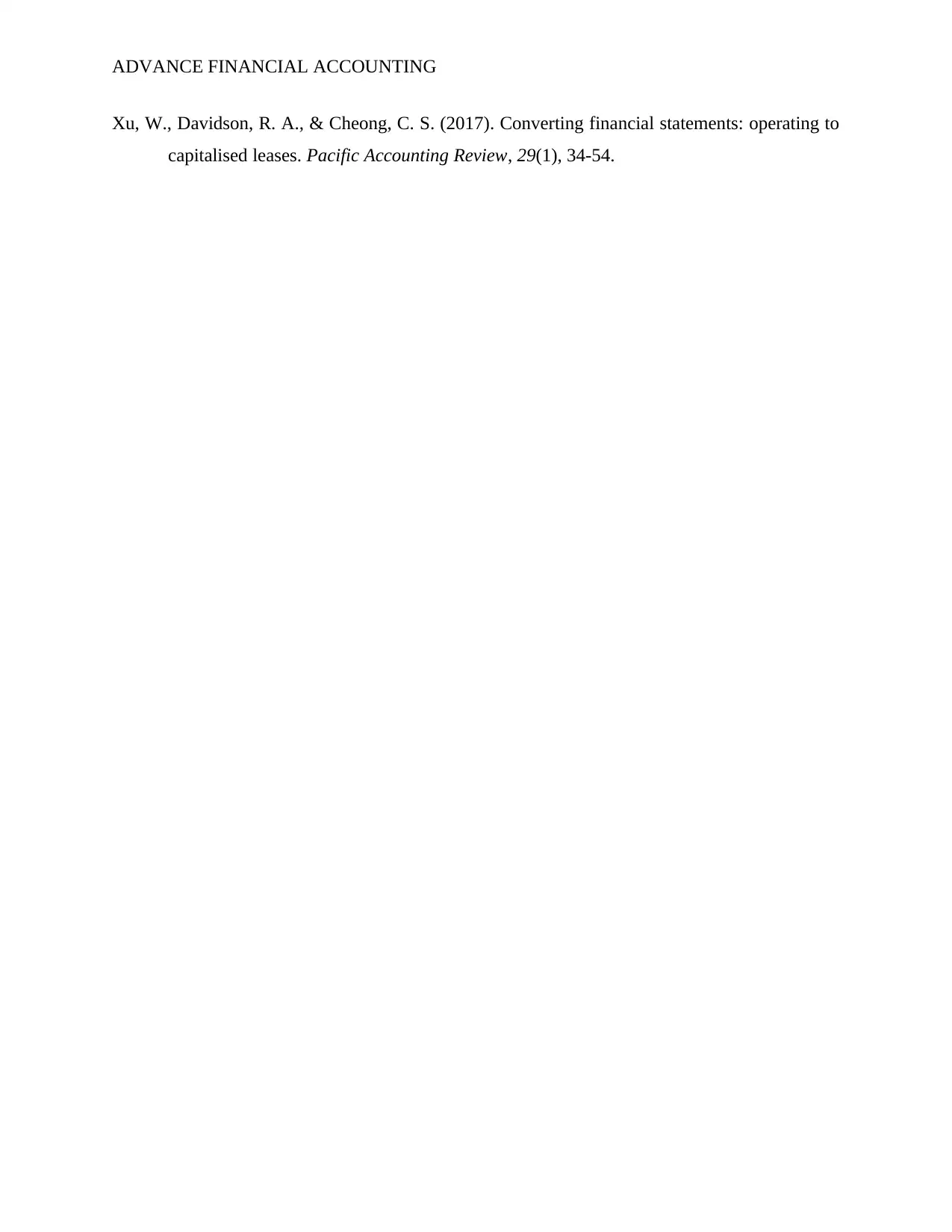
ADVANCE FINANCIAL ACCOUNTING
Xu, W., Davidson, R. A., & Cheong, C. S. (2017). Converting financial statements: operating to
capitalised leases. Pacific Accounting Review, 29(1), 34-54.
Xu, W., Davidson, R. A., & Cheong, C. S. (2017). Converting financial statements: operating to
capitalised leases. Pacific Accounting Review, 29(1), 34-54.
⊘ This is a preview!⊘
Do you want full access?
Subscribe today to unlock all pages.

Trusted by 1+ million students worldwide
1 out of 9
Related Documents
Your All-in-One AI-Powered Toolkit for Academic Success.
+13062052269
info@desklib.com
Available 24*7 on WhatsApp / Email
![[object Object]](/_next/static/media/star-bottom.7253800d.svg)
Unlock your academic potential
Copyright © 2020–2025 A2Z Services. All Rights Reserved. Developed and managed by ZUCOL.





